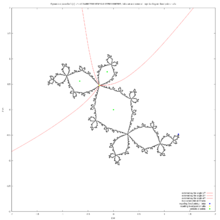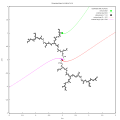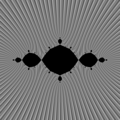分形/复平面迭代/动态外射线
- 落在alpha不动点上的射线
-
双可达
-
三可达
- 落在临界点和临界值上的射线
-
1/4
-
1/6
-
9/56
-
129/16256
令 为从闭合单位圆盘 的补集(外部)到填充的Julia集 的补集的映射(保角映射,同构)。
其中 表示黎曼球面(扩展复平面)。
令 表示
- 逆Boettcher映射
- 黎曼映射
角度为 的外射线记为 是
- 在 下的直线 的像
- 具有相同外部角 的填充后的 Julia 集外部的点集
重要问题
[edit | edit source]哪些是独特的射线?
[edit | edit source]- "落在 Julia 集的关键点(或包含关键点的球体的根点)上的射线 t 对该 Julia 集是唯一的,因此是识别 Julia 集的一种方式。因此,我用 t 来命名 Julia 集 Jc。在余下部分中,我只能处理 t=p/q 为有理数的 Julia 集。"[1]
- 临界前周期多项式通常由 落在临界值的外部射线 的角度 进行参数化
如何逼近外部射线?
[edit | edit source]- 用于 Julia 集的二进制分解方法 (BDM/J)
- 场线 的标量场(势)
- SAM = 条带平均方法 基本上是计算角度的一种廉价方式。
-
BDM 的边界
-
SAM
在 BDM 图像中,角度(以圈数测量)的外部射线
可以看作子集的边界。
当两个外部动态射线落在同一点时
[edit | edit source]问题:[2]
- Q1:给定 Julia 集中的一个点,有多少条射线落在该点上?
- Q2:给定两条射线 和 ,在什么条件下它们落在同一点?
- Q3:哪些射线支持相同的 Fatou 分量?
定理 1.2 设 f 为度数 d ≥ 2 的多项式,其 Julia 集局部连通。如果两个角度 和 关于临界肖像具有相同的行程,那么外部射线 和 的着陆点要么重合,要么属于 Fatou 域的边界,该边界最终被迭代到 Siegel 盘上。
如何找到落在临界值 z= c 上的外部射线的角度呢?
[edit | edit source]这取决于具体情况。
- 例如,当参数 c 是一个 Misiurewicz 点时,可以使用组合方法。
- 大多数情况下,你首先构造角度,然后确定参数。
- 但是,如果你想从 Julia 集或 Hubbard 树中读取角度,你可以按照 Mandel 程序 中的 Demo 4 第 1 和 2 页的说明进行。
构造 填充 Julia 集 的脊柱
[edit | edit source]构造脊柱的算法由 A. Douady[5] 描述
- 连接 和 ,
- (待完成)
绘制外部射线是什么意思呢?
[edit | edit source]这意味着
- 计算(近似)射线的某些点
- 用线段连接这些点
这将给出射线 的近似值。
绘制 动态外部射线
[edit | edit source]算法
逆向迭代
[edit | edit source]
这种方法已经被许多人使用,并被 Thierry Bousch 证明。[8]
Wolf Jung 的 C++ 代码可以在 qmnplane.cpp 文件中的 QmnPlane::backray() 函数中找到(参见 Mandel 程序 的源代码)。[9]
- 周期性角度的射线(最简单的情况)
我们将通过一个例子来解释它
首先选择外部角度 (以圈数为单位)。周期性射线的外部角度是一个有理数。
计算外部角度在 倍增映射 下的周期。
因为 "1/3 的倍增结果是 2/3,而 2/3 的倍增结果是 4/3,它与 1/3 同余" [10]
或者
因此外部角 在倍增映射下周期为2。
从无穷远处的两个点开始(在共轭平面上)
在射线 1/3 上有一个点
在射线 2/3 上有一个点 .
在无穷远附近 因此可以切换到动力学平面(博特切尔共轭)
向后迭代(从两个可能性中适当选择)[12] 在射线 1/3 上的点会到射线 2/3,再回到 1/3,依此类推。
在 C 语言中是
/* choose one of 2 roots: zNm1 or -zNm1 where zN = sqrt(zN - c ) */ if (creal(zNm1)*creal(zN) + cimag(zNm1)*cimag(zN) <= 0) zNm1=-zNm1;
或者在 Maxima CAS
if (z1m1.z01>0) then z11:z1m1 else z11:-z1m1;
必须将点集分成 2 个子集(2 条射线)。绘制这两个集合中的一个,并将这些点连接起来。它将近似于射线。
- 对于预周期角的射线(待完成)
/*
compute last point ~ landing point
of the dynamic ray for periodic angles ( in turns )
gcc r.c -lm -Wall -march=native
landing point of ray for angle = 1 / 15 = 0.0666666666666667 is = (0.0346251977103306 ; 0.4580500411138030 ) ; iDistnace = 18
landing point of ray for angle = 2 / 15 = 0.1333333333333333 is = (0.0413880816505388 ; 0.5317194187688231 ) ; iDistnace = 17
landing point of ray for angle = 4 / 15 = 0.2666666666666667 is = (-0.0310118081927549 ; 0.5440125864026020 ) ; iDistnace = 17
landing point of ray for angle = 8 / 15 = 0.5333333333333333 is = (-0.0449867688014234 ; 0.4662592852362425 ) ; iDistnace = 18
*/
// https://gitlab.com/adammajewski/ray-backward-iteration
#include <stdio.h>
#include <stdlib.h> // malloc
#include <math.h> // M_PI; needs -lm also
#include <complex.h>
/* --------------------------------- global variables and consts ------------------------------------------------------------ */
#define iPeriodChild 4 // iPeriodChild of secondary component joined by root point
// - --------------------- functions ------------------------
/*
principal square root of complex number
wikipedia Square_root
z1= I;
z2 = root(z1);
printf("zx = %f \n", creal(z2));
printf("zy = %f \n", cimag(z2));
*/
double complex root(double x, double y)
{
double u;
double v;
double r = sqrt(x*x + y*y);
v = sqrt(0.5*(r - x));
if (y < 0) v = -v;
u = sqrt(0.5*(r + x));
return u + v*I;
}
// This function only works for periodic angles.
// You must know the iPeriodChild n before calling this function.
// draws all "iPeriodChild" external rays
// commons File:Backward_Iteration.svg
// based on the code by Wolf Jung from program Mandel
// http://www.mndynamics.com/
int ComputeRays( //unsigned char A[],
int n, //iPeriodChild of ray's angle under doubling map
int iterMax,
double Cx,
double Cy,
double dAlfaX,
double dAlfaY,
double PixelWidth,
complex double zz[iPeriodChild] // output array
)
{
double xNew; // new point of the ray
double yNew;
const double R = 10000; // very big radius = near infinity
int j; // number of ray
int iter; // index of backward iteration
double t,t0; // external angle in turns
double num, den; // t = num / den
double complex zPrev;
double u,v; // zPrev = u+v*I
int iDistance ; // dDistance/PixelWidth = distance to fixed in pixels
/* dynamic 1D arrays for coordinates ( x, y) of points with the same R on preperiodic and periodic rays */
double *RayXs, *RayYs;
int iLength = n+2; // length of arrays ?? why +2
// creates arrays : RayXs and RayYs and checks if it was done
RayXs = malloc( iLength * sizeof(double) );
RayYs = malloc( iLength * sizeof(double) );
if (RayXs == NULL || RayYs==NULL)
{
fprintf(stderr,"Could not allocate memory");
getchar();
return 1; // error
}
// external angle of the first ray
num = 1.0;
den = pow(2.0,n) -1.0;
t0 = num/den; // http://fraktal.republika.pl/mset_external_ray_m.html
t=t0;
// printf(" angle t = %.0f / %.0f = %f in turns \n", num, den, t0);
// starting points on preperiodic and periodic rays
// with angles t, 2t, 4t... and the same radius R
for (j = 0; j < n; j++)
{ // z= R*exp(2*Pi*t)
RayXs[j] = R*cos((2*M_PI)*t);
RayYs[j] = R*sin((2*M_PI)*t);
//
// printf(" %d angle t = = %.0f / %.0f = %.16f in turns \n", j, num , den, t);
//
num *= 2.0;
t *= 2.0; // t = 2*t
if (t > 1.0) t--; // t = t modulo 1
}
//zNext = RayXs[0] + RayYs[0] *I;
// printf("RayXs[0] = %f \n", RayXs[0]);
// printf("RayYs[0] = %f \n", RayYs[0]);
// z[k] is n-periodic. So it can be defined here explicitly as well.
RayXs[n] = RayXs[0];
RayYs[n] = RayYs[0];
// backward iteration of each point z
for (iter = -10; iter <= iterMax; iter++)
{
for (j = 0; j < n; j++) // n +preperiod
{ // u+v*i = sqrt(z-c) backward iteration in fc plane
zPrev = root(RayXs[j+1] - Cx , RayYs[j+1] - Cy ); // , u, v
u=creal(zPrev);
v=cimag(zPrev);
// choose one of 2 roots: u+v*i or -u-v*i
if (u*RayXs[j] + v*RayYs[j] > 0)
{ xNew = u; yNew = v; } // u+v*i
else { xNew = -u; yNew = -v; } // -u-v*i
// draw part of the ray = line from zPrev to zNew
// dDrawLine(A, RayXs[j], RayYs[j], xNew, yNew, j, 255);
//
RayXs[j] = xNew; RayYs[j] = yNew;
} // for j ...
//RayYs[n+k] cannot be constructed as a preimage of RayYs[n+k+1]
RayXs[n] = RayXs[0];
RayYs[n] = RayYs[0];
// convert to pixel coordinates
// if z is in window then draw a line from (I,K) to (u,v) = part of ray
// printf("for iter = %d cabs(z) = %f \n", iter, cabs(RayXs[0] + RayYs[0]*I));
}
// Approximate end of ray by straight line to it's landing point here = alfa fixed point
// for (j = 0; j < n + 1; j++)
// dDrawLine(A, RayXs[j],RayYs[j], dAlfaX, dAlfaY,j, 255 );
// this check can be done only from inside this function
t=t0;
num = 1.0;
for (j = 0; j < n ; j++)
{
zz[j] = RayXs[j] + RayYs[j] * I; // save to the output array
// Approximate end of ray by straight line to it's landing point here = alfa fixed point
//dDrawLine(RayXs[j],RayYs[j], creal(alfa), cimag(alfa), 0, data);
iDistance = (int) round(sqrt((RayXs[j]-dAlfaX)*(RayXs[j]-dAlfaX) + (RayYs[j]-dAlfaY)*(RayYs[j]-dAlfaY))/PixelWidth);
printf("last point of the ray for angle = %.0f / %.0f = %.16f is = (%.16f ; %.16f ) ; Distance to fixed = %d pixels \n",num, den, t, RayXs[j], RayYs[j], iDistance);
num *= 2.0;
t *= 2.0; // t = 2*t
if (t > 1) t--; // t = t modulo 1
} // end of the check
// free memmory
free(RayXs);
free(RayYs);
return 0; //
}
int main()
{
complex double l[iPeriodChild];
int i;
// external angle in turns = num/den;
double num = 1.0;
double den = pow(2.0, iPeriodChild) -1.0;
ComputeRays( iPeriodChild,
10000,
0.25, 0.5,
0.00, 0.5,
0.003,
l ) ;
printf("\n see what is in the output array : \n");
for (i = 0; i < iPeriodChild ; i++) {
printf("last point of the ray for angle = %.0f / %.0f = %.16f is = (%.16f ; %.16f ) \n",num, den, num/den, creal(l[i]), cimag(l[i]));
num *= 2.0;}
return 0;
}
运行它
./a.out
输出
last point of the ray for angle = 1 / 15 = 0.0666666666666667 is = (0.0346251977103306 ; 0.4580500411138030 ) ; Distance to fixed = 18 pixels last point of the ray for angle = 2 / 15 = 0.1333333333333333 is = (0.0413880816505388 ; 0.5317194187688231 ) ; Distance to fixed = 17 pixels last point of the ray for angle = 4 / 15 = 0.2666666666666667 is = (-0.0310118081927549 ; 0.5440125864026020 ) ; Distance to fixed = 18 pixels last point of the ray for angle = 8 / 15 = 0.5333333333333333 is = (-0.0449867688014234 ; 0.4662592852362425 ) ; Distance to fixed = 19 pixels see what is in the output array : last point of the ray for angle = 1 / 15 = 0.0666666666666667 is = (0.0346251977103306 ; 0.4580500411138030 ) last point of the ray for angle = 2 / 15 = 0.1333333333333333 is = (0.0413880816505388 ; 0.5317194187688231 ) last point of the ray for angle = 4 / 15 = 0.2666666666666667 is = (-0.0310118081927549 ; 0.5440125864026020 ) last point of the ray for angle = 8 / 15 = 0.5333333333333333 is = (-0.0449867688014234 ; 0.4662592852362425 )
射线上的点正在向后移动
- 当它离茱莉亚集合很远时,速度很快
- 靠近茱莉亚集合时速度很慢(经过 50 次迭代后,点之间的距离 = 0 像素)
参见计算示例(这里 像素大小 = 0.003)
# iteration distance_between_points_in_pixels 0 3300001 1 30007 2 2296 3 487 4 179 5 92 6 54 7 34 8 23 9 18 10 14 11 11 12 9 13 7 14 6 15 5 16 5 17 4 18 4 19 3 20 3 21 3 22 3 23 2 24 2 25 2 26 2 27 2 28 2 29 2 30 1 31 1 32 1 33 1 34 1 35 1 36 1 37 1 38 1 39 1 40 1 41 1 42 1 43 1 44 1 45 1 46 1 47 1 48 1 49 1 50 1 51 1 52 1 53 1 54 1 55 1 56 0 57 0 58 0 59 0 60 0
可以选择像素大小不同的点
#iteration distance(z1,z2) distance (z,alfa)
0 3300001 33368
1 30007 3364
2 2296 1074
3 487 591
4 179 413
5 92 321
6 54 267
7 34 234
8 23 211
9 18 193
10 14 179
11 11 169
12 9 160
13 7 153
14 6 146
15 5 141
16 5 136
17 4 132
18 4 128
19 3 125
20 3 122
21 3 119
22 3 117
23 2 115
24 2 112
25 2 110
26 2 109
27 2 107
28 2 105
29 2 104
30 1 102
31 1 101
32 1 100
33 1 99
34 1 97
35 1 96
36 1 95
38 2 93
40 2 92
42 2 90
44 2 88
46 1 87
48 1 86
50 1 84
52 1 83
54 1 82
56 1 81
59 1 80
62 1 78
65 1 77
68 1 76
71 1 75
74 1 74
78 1 73
82 1 71
86 1 70
90 1 69
95 1 68
100 1 67
105 1 66
111 1 65
117 1 64
124 1 63
131 1 62
139 1 60
147 1 59
156 1 58
166 1 57
177 1 56
189 1 55
202 1 54
216 1 53
231 1 52
247 1 51
265 1 50
285 1 49
307 1 48
331 1 47
358 1 46
388 1 45
421 1 44
458 1 43
499 1 42
545 1 41
597 1 40
655 1 39
721 1 38
796 1 37
881 1 36
978 1 35
1090 1 34
1219 1 33
1368 1 32
1542 1 31
1746 1 30
1986 1 29
2270 1 28
2608 1 27
3013 1 26
3502 1 25
4098 1 24
4830 1 23
5737 1 22
6873 1 21
8312 1 20
10157 1 19
12555 1 18
15719 1 17
19967 1 16
25780 1 15
33911 1 14
45574 1 13
62798 1 12
89119 1 11
131011 1 10
201051 1 9
325498 1 8
564342 1 7
1071481 1 6
2308074 1 5
5996970 1 4
21202243 1 3
136998728 1 2
可以观察到,从像素 12 移动到 alfa 附近的像素 11 需要 27 000 次迭代。计算到 alfa 附近 1 像素内的点需要:2m1.236 秒
使用柯蒂斯·麦克穆伦的逆博特切尔映射绘制动态外部射线
[edit | edit source]
该方法基于柯蒂斯·麦克穆伦的 C 程序[13] 及马特亚兹·艾拉特的 Pascal 版本[14]
这里有两个平面[15]
- w-平面(或 f0 平面)
- z-平面(fc 平面的动力学平面)
该方法包含 3 个主要步骤
- 计算圆形外部射线在角 和不同半径(光栅化)上的某些 w 点
- 其中
- 使用逆博特切尔映射将 w 点映射到 z 点
- 绘制 z 点(并使用线段连接它们(线段是直线的一部分,由两个不同的端点界定[16]))
第一步和最后一步很容易,但第二步不容易,需要更多解释。
光栅化
[edit | edit source]对于给定的外部射线,在 平面 中,射线的每个点都有
- 常数 (外角以转为单位)
- 变量半径
所以 射线的点由半径 参数化,可以使用 复数的指数形式 计算。
可以使用 **线性尺度** 沿着射线前进。
t:1/3; /* example value */ R_Max:4; R_Min:1.1; for R:R_Max step -0.5 thru R_Min do w:R*exp(2*%pi*%i*t); /* Maxima allows non-integer values in for statement */
这会得到一些 w 点,这些点之间的距离相等。
另一种方法是使用 **非线性尺度**。
为了做到这一点,我们引入浮点 指数 ,使得
和
为了计算外射线在 平面上的角度为 的一些 w 点,使用以下 Maxima 代码
t:1/3; /* external angle in turns */ /* range for computing R ; as r tends to 0 R tends to 1 */ rMax:2; /* so Rmax=2^2=4 / rMin:0.1; /* rMin > 0 */ caution:0.93; /* positive number < 1 ; r:r*caution gives smaller r */ r:rMax; unless r<rMin do ( r:r*caution, /* new smaller r */ R:2^r, /* new smaller R */ w:R*exp(2*%pi*%i*t) /* new point w in f0 plane */ );
在这个方法中,点之间的距离并不相等,而是与填充的 Julia 集边界距离 成反比。
这是好的,因为在这里射线具有更大的 曲率,因此曲线会更加平滑。
- 在 平面中进行向前迭代
直到 接近无穷大
- 切换平面(从 到 )
(因为这里,接近无穷大:)
- 在 平面上进行反向迭代相同()次迭代次数
- 最后一个点 在我们的外部射线上
步骤 1、2 和 4 很容易。第三个不容易。
反向迭代使用复数的平方根。它是一个双值函数,因此反向迭代会产生二叉树。
在没有额外信息的情况下,无法在这样的树中选择正确的路径。为了解决这个问题,我们将使用两件事
- 无穷大吸引域的等度连续性
- 和 平面之间的共轭关系
无穷大吸引域的等度连续性
[edit | edit source]无穷大吸引域(填充的 Julia 集的补集)包含在正向迭代下趋于无穷大的所有点。
无穷大是一个超吸引不动点,所有点的轨道都具有类似的行为。换句话说,如果两个点的初始位置很接近,则它们的轨道被认为会保持接近。
这就是等度连续性(与正规性比较)。
在 平面上,可以使用射线先前点的正向轨道来计算下一个点的反向轨道。
算法的详细版本
[edit | edit source]- 计算射线的第一个点(从无穷大附近开始,朝 Julia 集移动)
- 其中
这里可以轻松切换平面
这是射线的第一個 z 点。
- 计算射线的下一个 z 点
- 计算射线的下一个 w 点,对于
- 计算两个点的正向迭代:前一个 z 点和当前 w 点。保存 z 轨迹和最后一个 w 点
- 切换平面并使用最后一个 w 点作为起点:
- 使用前一个 z 点的正向轨迹,对新的 进行反向迭代,直到新的
- 是射线的下一个 z 点
- 依此类推(下一个点),直到
Maxima CAS 源代码
/* gives a list of z-points of external ray for angle t in turns and coefficient c */ GiveRay(t,c):= block( [r], /* range for drawing R=2^r ; as r tends to 0 R tends to 1 */ rMin:1E-20, /* 1E-4; rMin > 0 ; if rMin=0 then program has infinity loop !!!!! */ rMax:2, caution:0.9330329915368074, /* r:r*caution ; it gives smaller r */ /* upper limit for iteration */ R_max:300, /* */ zz:[], /* array for z points of ray in fc plane */ /* some w-points of external ray in f0 plane */ r:rMax, while 2^r<R_max do r:2*r, /* find point w on ray near infinity (R>=R_max) in f0 plane */ R:2^r, w:rectform(ev(R*exp(2*%pi*%i*t))), z:w, /* near infinity z=w */ zz:cons(z,zz), unless r<rMin do ( /* new smaller R */ r:r*caution, R:2^r, /* */ w:rectform(ev(R*exp(2*%pi*%i*t))), /* */ last_z:z, z:Psi_n(r,t,last_z,R_max), /* z=Psi_n(w) */ zz:cons(z,zz) ), return(zz) )$
- ↑ 康奈尔大学的配对理论
- ↑ 射线一起着陆的判据,作者:曾金松(arXiv:1503.05931 math.DS)
- ↑ 作为动力学系统的临界前周期多项式的分类,作者:Ben Bielefeld、Yuval Fisher 和 John Hubbard
- ↑ 关于临界有限多项式的第一部分:临界肖像,作者:Alfredo Poirier
- ↑ A. Douady,“计算 Mandelbrot 集中角度的算法”,在混乱动力学和分形,M. Barnsley 和 S. G. Demko 编,科学与工程数学笔记与报告,第 2 卷,第 155–168 页,学术出版社,亚特兰大,佐治亚州,美国,1986 年。
- ↑ 作为微分方程轨迹的不变康托集族 II:Julia 集,作者:陈一泉、川平朋树、袁俊明
- ↑ 绘制 Mandelbrot 集外部射线的算法,作者:川平朋树
- ↑ Thierry Bousch:外部射线旋转了多少?未发表的手稿,1995 年
- ↑ Wolf Jung 编写的 Mandel 程序
- ↑ Wolf Jung 的解释
- ↑ 维基百科中的模算术
- ↑ 复数的平方根给出 2 个值,因此必须只选择一个。有关详细信息,请参阅 Wolf Jung 页面
- ↑ Curtis McMullen 编写的 c 程序(Julia.tar.gz 中的 quad.c)
- ↑ 二次多项式,作者:Matjaz Erat
- ↑ 维基百科:复二次多项式 / 平面 / 动力学平面
- ↑ 维基百科:线段































































